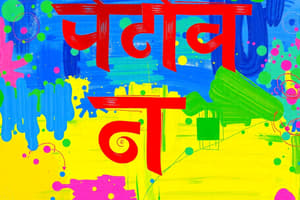Podcast
Questions and Answers
What is the approximate number of native speakers of Hindi worldwide?
What is the approximate number of native speakers of Hindi worldwide?
- 800 million
- 300 million
- 450 million
- 615 million (correct)
Which language is considered the parent language of Hindi?
Which language is considered the parent language of Hindi?
- Sanskrit (correct)
- Khariboli
- Braj Bhasha
- Urdu
What are some factors that led to the evolution of different dialects of Hindi?
What are some factors that led to the evolution of different dialects of Hindi?
- Geographical isolation, trade, and cultural exchange (correct)
- Political boundaries
- Social media influence
- Genetic factors
In what script are both Hindi and Urdu languages written?
In what script are both Hindi and Urdu languages written?
How does Urdu differ from Hindi?
How does Urdu differ from Hindi?
Which country besides India has adopted Hindi as an official language?
Which country besides India has adopted Hindi as an official language?
Which region of India is the Braj dialect of Hindi mainly spoken in?
Which region of India is the Braj dialect of Hindi mainly spoken in?
What is one of the key characteristics of Avadhi, a dialect of Hindi?
What is one of the key characteristics of Avadhi, a dialect of Hindi?
In which regions of India is the Bhojpuri dialect of Hindi predominantly spoken?
In which regions of India is the Bhojpuri dialect of Hindi predominantly spoken?
Which aspect is Rajasthani, a dialect of Hindi, known for?
Which aspect is Rajasthani, a dialect of Hindi, known for?
How has technology impacted the usage of Hindi in the digital age?
How has technology impacted the usage of Hindi in the digital age?
What factor contributed to the widespread use and relevance of Hindi in the modern world?
What factor contributed to the widespread use and relevance of Hindi in the modern world?
Flashcards are hidden until you start studying
Study Notes
Hindi
Hindi is a widely spoken Indian language belonging to the Indo-Aryan branch of the Indo-European family of languages. It has approximately 615 million native speakers around the world, making it one of the most spoken languages globally. Hindi is the official language of India and Nepal, while also being widely used in other countries such as Fiji, Guyana, Mauritius, New Zealand, Singapore, Suriname, Trinidad and Tobago, and the United States.
Origin of Hindi
The origin of Hindi can be traced back to Sanskrit, which is considered its parent language. Over time, Hindi evolved into several regional languages like Braj Bhasha, Hindi, Khariboli, Shauraseni, and Haryanvi. These dialects underwent changes due to factors like geographical isolation, trade, cultural exchange, and the influence of neighboring languages. Eventually, Hindi emerged as a distinct language from Sanskrit.
Features and Characteristics of Hindi
Hindi shares similarities with Urdu, another prominent Indian language. Both languages use the same script, Devanagari, and share many vocabulary words. However, there are significant differences between the two languages, primarily in terms of grammar rules and pronunciation. For instance, while Hindi follows the principles of Standard Hindi grammar, Urdu has its own unique grammar rules that deviate from those of Standard Hindi.
One of the notable characteristics of Hindi is the vastness of its vocabulary. With over 250,000 words, the Hindi language boasts one of the largest vocabularies among the world's languages. Additionally, Hindi employs a complex grammatical structure that includes 19 cases and four degrees of grammatical categories.
Dialects and Variants of Hindi
Hindi has several dialects and variants that are spoken across different regions of India. Some of the prominent dialects include Braj, Avadhi, Bhojpuri, and Rajasthani. Each of these dialects has its unique features and characteristics that set them apart from Standard Hindi.
Braj
Braj is a dialect of Hindi that is mainly spoken in the Braj region of Uttar Pradesh, India. It is known for its poetic and literary traditions, often used in devotional poetry, epics, and dramas.
Avadhi
Avadhi is another dialect of Hindi that is spoken in the Avadh region of Uttar Pradesh, India. It is characterized by its unique grammar rules, which deviate from those of Standard Hindi.
Bhojpuri
Bhojpuri is a dialect of Hindi that is predominantly spoken in the eastern parts of Uttar Pradesh and Bihar in India. It is known for its fusion of Hindi and local languages, resulting in a distinct linguistic identity.
Rajasthani
Rajasthani is a dialect of Hindi that is primarily spoken in the Rajasthan region of India. It is known for its unique grammar rules and rich cultural heritage, often reflected in its literature and folklore.
Hindi in the Digital Age
With the advent of technology and digital communication, Hindi has gained significant traction in the digital realm. Social media platforms, messaging apps, and search engines have enabled Hindi speakers to communicate and access information in their native language. As a result, Hindi has become increasingly relevant in the digital age, with a growing presence on the internet and within digital media.
In conclusion, Hindi is a rich and diverse language with a significant impact on the world. Its origins can be traced back to Sanskrit, and it has evolved into several regional dialects and variants. Hindi's large vocabulary, complex grammar, and rich cultural heritage have contributed to its widespread use and relevance in the modern world. With the rise of digital communication, Hindi has continued to thrive and adapt to meet the needs of its speakers in the digital age.
Studying That Suits You
Use AI to generate personalized quizzes and flashcards to suit your learning preferences.




